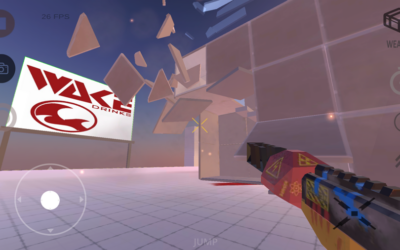Game Spotlight: Pixel Strike 3D from Vulcron
Canadian developer Vulcron has been successfully monetizing its retro-inspired FPS Pixel Strike 3D with InGamePlay ads for nearly year now. So we asked the team at Vulcron to tell us about their experience integrating in-game advertising into the fast-paced shooter.
A Brief History of Pixel Strike 3D
Released in 2016, Pixel Strike 3D was Vulcron’s first foray into the world of mobile gaming. And it’s proven a successful one; the FPS now has over 5 million installs on the Google Play Store alone, as well as a well-received Steam version of the game available.
In-Game Advertising Integration
In Pixel Strike 3D, Vulcron has placed InGamePlay brands ads tactically as their players move through the game’s maps, focusing on high-traffic areas and chokepoints. An ad is also placed on the game’s character customization screen, which is an excellent move as the extended dwell time translates into a lot of impressions.
What were the inspirations and core design pillars behind Pixel Strike 3D?
In today’s gaming world many games are bloated, require high-end devices to play, and take a long time to get comfortable playing. Our goal with Pixel Strike 3D is to create a fun, lightweight, easily accessible first-person shooter that people of any skill level can jump right into and enjoy.
How did you find using the SDK to integrate InGamePlay ads into your game?
Integration was very easy and worked out of the box without any extra code or implementation on our end. We were able to easily set up ad prefabs and place them around our game.
Tell us about how you designed your ad placement strategy
Our ad placement strategy is fairly straightforward. We place ads around each map in areas that we find to be high traffic such as hallways or entranceways, as well as the main menu where players spend time customizing their character.
How do you think in-game advertising compares to traditional mobile ads?
In-game advertising is a great way to monetize without intruding on the player’s gameplay experience. We’re able to use existing map decorations like billboards and signs and turn them into revenue-generating ads without any negative impact on player experience.
Pixel Strike 3D is a fast-paced FPS, did that present any challenges when it came to placing and optimising your ad placements?
Even though Pixel Strike 3D is a fast-paced game, we’re still able to effectively utilize in-game advertising because of how AdInMo can track impressions across multiple placements with minimal screen-time.
More…
Revenue Optimization: ARPDAU and ImpDAU
For mobile game developers, revenue optimization is of course always top of mind. AdInMo pays developers monthly, based on an impression volume. Our dashboards report several key metrics including eCPM, but when you consider the question “how much additional revenue...
We’re hiring an SDK developer
Job Description – SDK Developer (Unity + Unreal), Full-time / Permanent, Edinburgh Are you not entertained? Love free-to-play games? Hate all those ads? We do too, and we’re doing something about it! We are: AdInMo is the leading Dynamic In-Game...
Techstart Ventures backs in-game ad platform AdInMo in $500K seed funding round
AdInMo appoints ex-delta DNA co-founder Chris Wright as Chief Technology Officer 20th, May 2020, Edinburgh: AdInMo, the programmatic ad platform for video games, has secured a $500K investment round led by Techstart Ventures, a leading investor in start-ups across...



